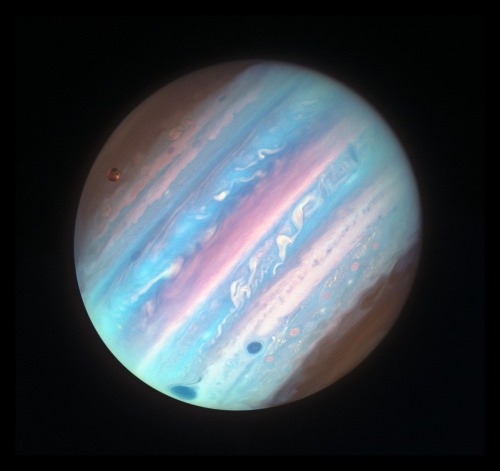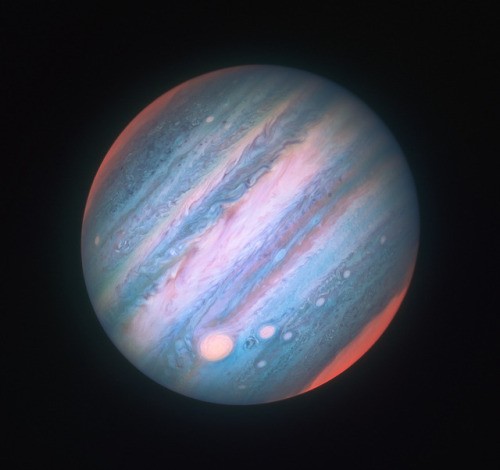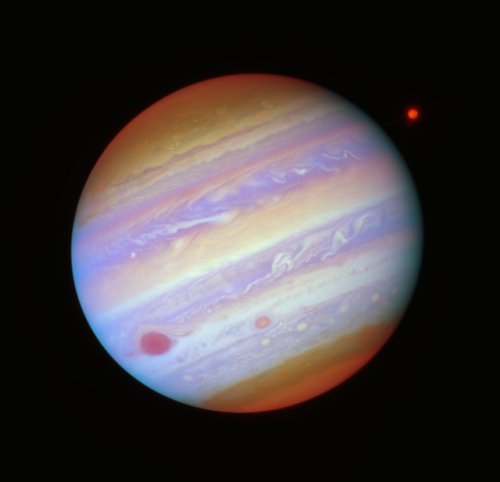Evocation
Evocation
Ὦ Ζεῦ,
we named the second brightest wanderer for you
Κρονίδη
but did not know until Cassini, far-seeing
saw the storms upon your throne,
Μαιμάκτη
and the vast red hurricane
More Posts from Jovian-witch and Others
![Voyager 1 Approaching Jupiter In 1979. [Reddit/spacegifs]](https://64.media.tumblr.com/57003d3715c75582218ee1b20aeb6a70/tumblr_p21webfuy81s04h2ho1_400.gif)
Voyager 1 approaching Jupiter in 1979. [Reddit/spacegifs]

cosmic witchcraft 101: jovian magick ♃
Jupiter is the fifth planet from the Sun. Due to its massive size, there are multiple ways the planet could have formed. Regardless of its formation process, some scientists believe that Jupiter migrated inward right up to the orbit of Mars after its initial formation. This is referred to as the Grand Tack Hypothesis. In the early solar system, Neptune and the other outer planets may have begun interacting with icy planetesimals, sending comets from one planet to the next, causing Uranus, Neptune, and Saturn to move outwards as the comets moved inwards. When the comets reached Jupiter, the planet’s massive gravity flung the comets into highly elliptical orbits or out of the solar system entirely and Jupiter migrated inwards to conserve angular momentum.
As it made its way towards the Sun, Jupiter’s gravity would have prevented the asteroid belt material from forming into planets and swept away large amounts of material that may have made Mars more massive. Thanks to Saturn, Jupiter stopped its inward migration and turned around, settling approximately where we see it today. As Jupiter moved inward and Saturn moved outward, it’s theorized that they became locked in a 3:2 orbital resonance, with Saturn finishing 3 orbits around the Sun for Jupiter’s 2. Jupiter’s migration may have also brought icy and gaseous material into the inner solar system, helping the inner planets form their atmospheres and perhaps even providing those vital life-giving compounds we can thank for our existence today.
Facts:
Jupiter produces more heat than it receives from the Sun.
Jupiter is more than twice as massive as all the other planets combined.
The planet has at least 67 moons.
Jupiter is NOT a failed star. The smallest stars in the observable universe have about 1/12 of the Sun’s mass, and Jupiter has about 1/1000th of the Sun’s mass. Jupiter is simply a colossal planet.
The Great Red Spot is larger than Earth. It’s a colossal hurricane that’s been going on since the 17th century, maybe even before that.
Jupiter rotates faster than any of the other planets; a Jovian day is only about 10 Earth hours. It takes 11.86 years to orbit around the Sun.
Lighter stripes along the planet are called zones and darker stripes are called belts. They flow in opposite directions and turbulence between regions causes the Jupiter’s storms.
Magickal Correspondences*
Colors: red, white, yellow, brown, purple
Intents: growth, expansion, prosperity, justice, exploration, freedom, protection, spiritual evolution, success, meditation, psychic development, confidence, storm magick
Herbs: frankincense, rosemary, oak, cedar, nutmeg, sage, anise, catnip, sandalwood, rosehips, dandelion, fennel, tansy
Crystals: tin, amethyst, lepidolite, sugilite, lapis lazuli, sapphire, diamond, agate, antimony, rhodocrosite, aragonite, jasper, onyx, amber
*some of these correspondences are based on traditional associations and some are based on my personal associations

For Jupiter and its limitless expansion.
Real stoked with how this one came out 💪🏻


Jupiter's Moon IO: Jupiter's fifth moon, Io, is the most volcanically active body in the solar system. Io's surface temperature averages about minus 202 degrees Fahrenheit (minus 130 Celsius), resulting in the formation of sulfur dioxide snowfields. But Io's volcanoes can reach 3,000 F (1,649 C). Io is often referred to as a celestial body of fire and ice. (source)
cosmic witchcraft 101: jovian magick ♃
Jupiter is the fifth planet from the Sun. Due to its massive size, there are multiple ways the planet could have formed. Regardless of its formation process, some scientists believe that Jupiter migrated inward right up to the orbit of Mars after its initial formation. This is referred to as the Grand Tack Hypothesis. In the early solar system, Neptune and the other outer planets may have begun interacting with icy planetesimals, sending comets from one planet to the next, causing Uranus, Neptune, and Saturn to move outwards as the comets moved inwards. When the comets reached Jupiter, the planet’s massive gravity flung the comets into highly elliptical orbits or out of the solar system entirely and Jupiter migrated inwards to conserve angular momentum.
As it made its way towards the Sun, Jupiter’s gravity would have prevented the asteroid belt material from forming into planets and swept away large amounts of material that may have made Mars more massive. Thanks to Saturn, Jupiter stopped its inward migration and turned around, settling approximately where we see it today. As Jupiter moved inward and Saturn moved outward, it’s theorized that they became locked in a 3:2 orbital resonance, with Saturn finishing 3 orbits around the Sun for Jupiter’s 2. Jupiter’s migration may have also brought icy and gaseous material into the inner solar system, helping the inner planets form their atmospheres and perhaps even providing those vital life-giving compounds we can thank for our existence today.
Facts:
Jupiter produces more heat than it receives from the Sun.
Jupiter is more than twice as massive as all the other planets combined.
The planet has at least 67 moons.
Jupiter is NOT a failed star. The smallest stars in the observable universe have about 1/12 of the Sun’s mass, and Jupiter has about 1/1000th of the Sun’s mass. Jupiter is simply a colossal planet.
The Great Red Spot is larger than Earth. It’s a colossal hurricane that’s been going on since the 17th century, maybe even before that.
Jupiter rotates faster than any of the other planets; a Jovian day is only about 10 Earth hours. It takes 11.86 years to orbit around the Sun.
Lighter stripes along the planet are called zones and darker stripes are called belts. They flow in opposite directions and turbulence between regions causes the Jupiter’s storms.
Magickal Correspondences*
Colors: red, white, yellow, brown, purple
Intents: growth, expansion, prosperity, justice, exploration, freedom, protection, spiritual evolution, success, meditation, psychic development, confidence, storm magick
Herbs: frankincense, rosemary, oak, cedar, nutmeg, sage, anise, catnip, sandalwood, rosehips, dandelion, fennel, tansy
Crystals: tin, amethyst, lepidolite, sugilite, lapis lazuli, sapphire, diamond, agate, antimony, rhodocrosite, aragonite, jasper, onyx, amber
*some of these correspondences are based on traditional associations and some are based on my personal associations
Jupiter ♃
Associations: Gain, riches, prosperity, wealth, success, luck, self-confidence, investment, gatherings, favors, ambition, mercy, humanity, publicity
Botanicals: Anise, bayberry, bergamot, blessed thistle, carnation, catnip, chamomile, cinquefoil, clove, clover, corn, crampbark, eyebright, hops, hyssop, nutmeg, oak, sage, stevia, tulip
Crystals: Yellow sapphire, yellow apatite, yellow jasper, green aventurine, azurite, lepidolite, kyanite
Metals: Tin
Colors: Blue, purple, yellow
Numbers: 3
Elements: Air
Zodiac Signs: Sagittarius
Day of the Week: Thursday
compiled from my personal grimoire

Jupiter in infrared, Shoemaker–Levy 9 collision (left), Io (right)
Comet Shoemaker–Levy 9 was a comet that broke apart in July 1992 and collided with Jupiter in July 1994, providing the first direct observation of an extraterrestrial collision of Solar System objects. This generated a large amount of coverage in the popular media, and the comet was closely observed by astronomers worldwide. The collision provided new information about Jupiter and highlighted its possible role in reducing space debris in the inner Solar System.
source



Jupiter (filtered) by Judith Schmidt.
-
 nerdsgaysandarcherybabes liked this · 2 years ago
nerdsgaysandarcherybabes liked this · 2 years ago -
 piristephes liked this · 2 years ago
piristephes liked this · 2 years ago -
 jovian-witch reblogged this · 3 years ago
jovian-witch reblogged this · 3 years ago -
 a-exists liked this · 3 years ago
a-exists liked this · 3 years ago -
 desertskysong liked this · 3 years ago
desertskysong liked this · 3 years ago -
 evergreen-lyricist liked this · 3 years ago
evergreen-lyricist liked this · 3 years ago -
 copperhearths reblogged this · 3 years ago
copperhearths reblogged this · 3 years ago -
 persephonesdarling liked this · 3 years ago
persephonesdarling liked this · 3 years ago -
 witches-will-be-witches reblogged this · 3 years ago
witches-will-be-witches reblogged this · 3 years ago -
 borderlinehannibal liked this · 3 years ago
borderlinehannibal liked this · 3 years ago -
 wandererslyric liked this · 3 years ago
wandererslyric liked this · 3 years ago -
 talonofjasper liked this · 3 years ago
talonofjasper liked this · 3 years ago -
 vaciena liked this · 3 years ago
vaciena liked this · 3 years ago -
 the-colors-of-heart liked this · 3 years ago
the-colors-of-heart liked this · 3 years ago -
 jacob-frye-appreciation-blog liked this · 3 years ago
jacob-frye-appreciation-blog liked this · 3 years ago -
 bruisae liked this · 3 years ago
bruisae liked this · 3 years ago -
 mxmcmoon liked this · 3 years ago
mxmcmoon liked this · 3 years ago -
 piristephes reblogged this · 3 years ago
piristephes reblogged this · 3 years ago -
 theoiprayers reblogged this · 3 years ago
theoiprayers reblogged this · 3 years ago -
 aoidaikallea reblogged this · 5 years ago
aoidaikallea reblogged this · 5 years ago

blog dedicated to my work with the planet Jupiter
96 posts